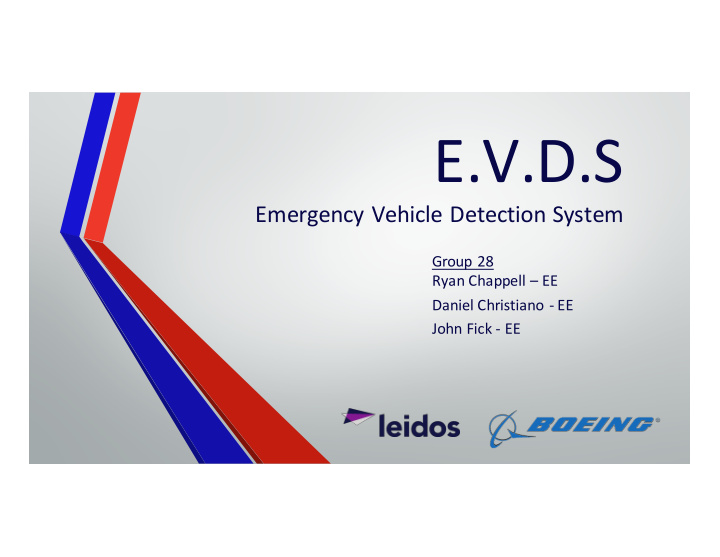



E.V.D.S Emergency Vehicle Detection System Group 28 Ryan Chappell – EE Daniel Christiano - EE John Fick - EE
E.V.D.S • Motivation • To decrease frequency of accidents involving Emergency Vehicles • Modern soundproofing technology has muted the driver to the outside world • Provide a link between the driver and the outside world An ambulance carrying a patient in critical condition is struck by an unaware driver in Portland, Oregon.
E.V.D.S • Objective • To alert drivers to the presence of emergency vehicles • Identify an emergency vehicle within 50 yards (stationary) • Identify position of emergency vehicle relative to vehicle • Requirements • Compatible with most consumer vehicles
E.V.D.S • Standards • USDoTEmergency Vehicle Siren Standards • States that Sirens must be below 120 dB • No Applicable Automotive Standards for this stage • 12 volt battery or alternator for power • DC power
E.V.D.S • Specifications Part Function Specification 120 o Cardioid Pattern Microphone Polar Pattern Filter Bandpass 338.6-3386 Hz Gain 6943 ADC Bit Resolution 12 bit Sampling Rate >44000 Hz DSP/Decision Logic Response TIme 2.5 seconds Accuracy <5% false negative Accuracy <10% false positive
E.V.D.S
E.V.D.S
E.V.D.S • Microphones • Shure SM 58 • Frequency Response • Cardioid Polar Pattern • Affordable • Versatile • Dynamic • Number • Orientation • Positioning
E.V.D.S • Filter • Two second order Butterworth filters • Passband range: 338.6 Hz –3386.3 Hz • Gain: 6943.75 • Quality factor of low pass: 2 • Quality factor of high pass: 2 • Bandpass Filter below: • Low-pass Filter Shown Below
E.V.D.S • Filter - PCB
E.V.D.S • Processor - ADC • TMS320F28377S • Sample and Hold ADC • Bit Resolution- 12 Bit • 100 KHz clock rate
E.V.D.S • Processor - DSP • TMS320F28377S • Fourier Transformations • Sample segments • 26 transforms a second • Finding frequency and amplitude
E.V.D.S • Processor – Decision Logic • TMS320F28377S • Using calculated frequencies • Compares sampled frequencies to known siren frequencies • Compares sampled frequencies to previous sampled frequencies • Determines when input frequencies match siren pattern range
E.V.D.S • Processor – Directional Identification • TMS320F28377S • Using Recorded Amplitudes • Compare the four amplitude values • The microphone(s) with the greatest amplitude indicate the direction of the Emergency Vehicle
E.V.D.S • Processor – PWM as DAC • TMS320F28377S • Generating output audio signal • Using a PWM as method of producing audio warning signals. • 1Khz beeps as warning signals
E.V.D.S • Visual Output • LED Heads Up Display • 8 LEDs in a 4 Directional Configuration • Light up four at a time to indicate direction of siren
E.V.D.S • Audio System – Receiver • Technics SA-DX940(Simulated Car Audio) • Inputs 8 • Outputs 5 • Power Source 120V AC
E.V.D.S • Audio System – External Amplifier • Kinter MA-180 • Inputs 2 • Outputs 2 • Power Source 12 V DC
E.V.D.S • Audio System – Speakers • Cambridge Soundworks • Extremely Similar to Car Audio Speakers
E.V.D.S • Power Supply • Car Battery (Simulated by 12V DC Wall Plug) • 12.6 V Supplied • 3.3 V for Processor • Voltage Regulator incorporated into PCB Design • 12.6 V for Amplifier and receiver
E.V.D.S • Negative Voltage • Dr. Meter HY3005-M • Simulates Negative voltage Rail in Car
E.V.D.S • PCB • Tl084 – General Purpose Operational Amplifier • 1.4 mA/Ch power consumption • 13 V/us slew rate • Vcc up to 18 V • Input Voltage up to Vcc+- • Cost: $10.23 for 10
E.V.D.S • PCB • TPS62162 – Buck Voltage Converter • 3-17 V input range • Output Voltage .9 –6 V • Output current up to 1 A • Common use is with 12 V rails • Cost: Sampled from TI
E.V.D.S • PCB • FT2232H – USB to Multipurpose • USB to JTAG • Allows for one port for power and computer communication • 3.3 V input • Cost: $6.71- Digikey
E.V.D.S Initial Budget Description Amount Microphones (4) $548 Processor $50 PCB $100 Wiring $20 Battery $50 Siren $50 Car Receiver $100 Speakers $50 Amplifier $100 Hardware $10 “Car” $10 ADC (4) $20 Total $1108
E.V.D.S Updated Budget Description Amount Microphones (4) $210 Processor $60 PCB $180 PCB Parts $160 Wiring $20 Power Supply $70 Siren $0 Car Receiver $0 Speakers $0 Amplifier $15 Hardware $10 “Car” $40 Testing Supplies $100 Total $865
E.V.D.S • Design Progress • Audio Input/Output 100 • 100% 90 • Code 80 70 • 100% 60 • PCB 50 40 • 100% 30 • Testing Procedure 20 • 100% 10 0 • Total Audio I/O Code PCB Test Total Procedure • 100%
E.V.D.S • Build Progress • Audio Input/output Build 100 • 100% 90 • Code Build 80 70 • 100 % 60 • PCB Print 50 40 • 100 % 30 • Testing Platform Build 20 • 100 % 10 0 • Total Audio I/O Code PCB Test Total Procedure • 100 %
E.V.D.S Component Primary Secondary Microphones Ryan ADC Daniel Filter Daniel John/Ryan DSP Daniel Ryan Decision Logic John Ryan DAC John Daniel Testing Platform John/Ryan Warning(visual, audio) John/Daniel Ryan Testing Everyone PCB Daniel Administrative Content Ryan Daniel/John
E.V.D.S • Lessons Learned • Populating your own PCB is incredibly difficult • Paying to have it populated is even more difficult on your wallet • Ground planes are necessary on PCBs • Cheap components may catch fire • Formatting in Microsoft Word is nearly impossible • Having a CpEin a coding heavy project would be useful • Can use PWM as DAC
E.V.D.S Questions?
E.V.D.S Demonstrations
E.V.D.S
E.V.D.S
E.V.D.S Questions?
Recommend
More recommend